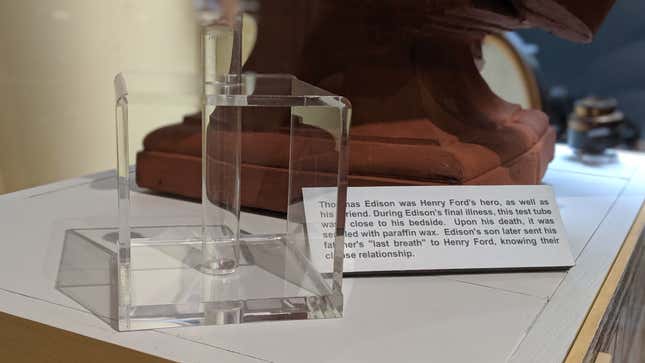
The Henry Ford museum in Dearborn, MI, has tons of interesting exhibits dedicated to turn-of-the-century industrialism. But tucked away, behind a still-running Edison Triple Expansion Steam engine in a section called Made in America, is a small case which gives you a glimpse into not only one of the great friendship of the 20th century, but just how creepy our American forebears were. Inside an exhibit dedicated to Thomas Edison and his competitors is presented a vial filled with the inventor’s dying breath.
It’s a strange exhibit, to be sure. The same case also contains Nikola Tesla’s death mask, gazing forever on the still-running Edison engine, which seems a little cruel considering their cut-throat relationship. But back to the vial. Exactly how the vial came to be in the museum’s possession goes all the way back to 1896, when Henry met Thomas.
Henry Ford and Thomas Edison were titans of the 20th century, and surprisingly close friends. Ford considered Edison his boyhood hero and, when the two met at a convention of the Association of Edison Illuminating Companies in 1896 Ford was ecstatic, even capturing a candid photo of the inventor. Ford was there because he was an engineer working for one of Edison’s subsidiary companies, Detroit Edison. The introduction was described in I Invented The Modern Age: The Rise of Henry Ford, which lays out a more than a little over-the-top meeting between the two. Ford was introduced to Edison as an inventor of the gas-powered car, which was both wrong and (given that this was a conference about electric power) also perceived as a slight by the chip-on-his-shoulder Ford. But according to the account, Edison was into it, and supposedly began peppering Ford with questions before he banged on the table and declared, “Your car is self-contained–carries its own power plant–no fire, no boiler, no smoke and no steam. You have the thing. Keep at it.” Ford would later say that that bang on the table meant the world to him.
Thomas Edison was not known as a warm or friendly guy, but several years later, as Ford’s star rose, Edison and the automaker began corresponding. The pair even worked together on projects, mostly Ford supplying the cash and Edison losing it on failed products.
The two men even took annual camping tips together along with their families or sometimes with Harvey Firestone, the founder of Firestone Tire and Rubber, President Warren Harding, and naturalist John Burroughs. They even bought houses next to each other and tried to build an electric car together, with disastrous results.

Thomas Edison died of complications due to diabetes on October 18, 1931 in West Orange, New Jersey at 84 years old. There at his side was Edison’s personal physician and his son, Charles Edison. The way the museum describes it, the idea to capture the inventor’s final breath came to Charles when he noticed an empty test tube rack by his dying father’s bedside. Charles gathered several vials full of Edison’s final breath, had the doctor seal the tubes in paraffin, and sent one to Henry Ford as a memento of their close friendship.
What are we supposed to make of this story, particularly that there are multiple vials of an intrinsically-singular last breath? Well, at the very least, it stands a testament to how, uh, intense the friendship was between these two very well-adjusted historical figures.
The legacies of these two giants of the electric age are incredibly intertwined. Even the building the vial sits in is a testament to their friendship. The Henry Ford Museum was built by Ford as a museum dedicated to industrial history. Originally named the Edison Institute, it opened on the 50th anniversary of the invention of the electric light bulb. The adjacent Greenfield Village recreates turn-of-the-century life in America, and even contains Edison’s original Menlo Park laboratory.
While the name may have changed, the museum is still dedicated to the history of manufacturing in general as well as the Ford Motor Company’s history specifically. When Henry Ford died over a decade after Edison, many of his personal items made their way into the museum’s collection—including the last breath of his mentor and friend. There’s no way to know if this is the very last breath of Edison, or if the precious terminus inventor gasses didn’t escape long ago, but it still a fascinating piece of the American story. Today it sits, practically hidden, as a small, unassuming reminder of a friendship at the top of the world.